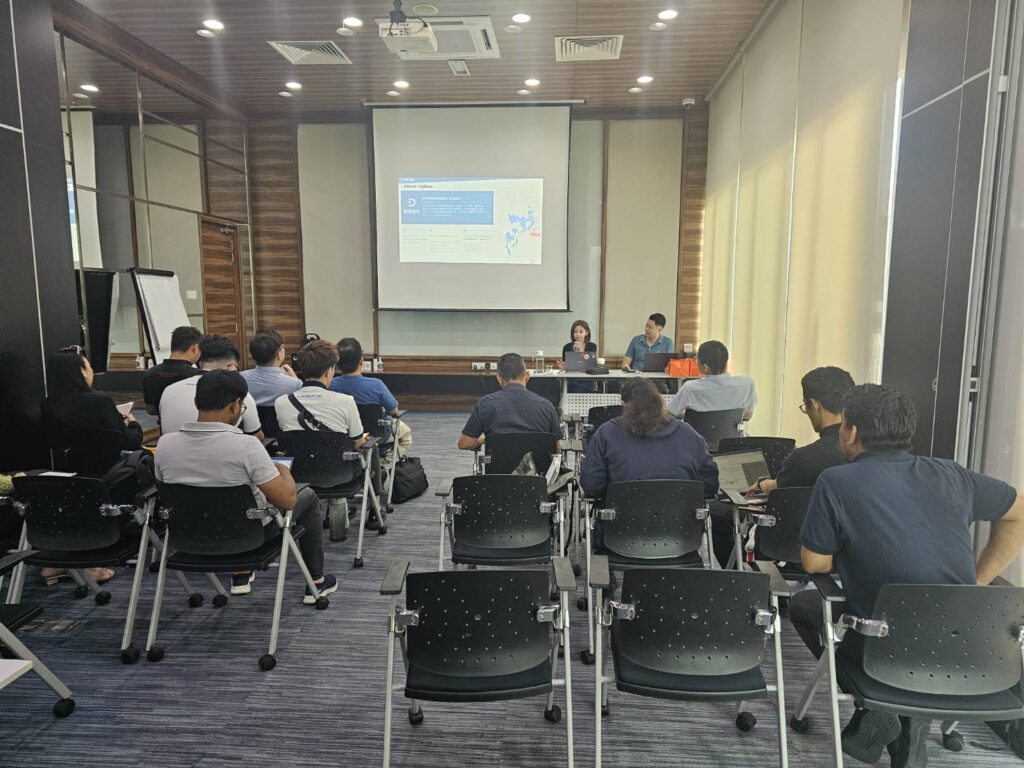Introduction
In today’s manufacturing landscape, digital transformation is no longer optional—it is essential for survival. Yet, many companies invest heavily in new systems only to see their transformation efforts fail.
From our experience, the root causes are rarely technological. Instead, they stem from insufficient executive support, organizational resistance, unclear requirements, and the absence of governance mechanisms, all of which make projects difficult to implement effectively.
Many manufacturers also tend to focus primarily on implementing systems such as ERP, MES, or APS, or on upgrading equipment and technologies—while overlooking the most critical driver of transformation: people.
For transformation to succeed, 80% depends on people, culture, and management behavior, and only 20% on technology. Without shared understanding, motivation, and capability, even the most advanced tools can become little more than surface-level improvements.
This guide places people at the core of transformation. Drawing from DigiHua Intelligent’s extensive practical experience, it introduces a five-stage roadmap and explores the challenges, pitfalls, and advisory roles that shape successful digital transformation.
Our goal is to help manufacturers build sustainable digital competitiveness—not just through technology, but through mindset, culture, and collective capability.
Summary
This article outlines how manufacturers can approach digital transformation with a renewed mindset—while avoiding the seven common pitfalls that often hinder success.
Drawing on its extensive experience, DigiHua Intelligent unveils industry insights rarely discussed openly, helping manufacturing partners better identify pain points and set clear transformation goals. Key approaches include strategies such as “Pilot First, Scale Later” and diagnostic frameworks based on the classic 5M model—Man, Machine, Material, Method, and Environment.
We also recognize that when organizations attempt to self-assess, issues often intertwine, making analysis and decision-making difficult. That’s why this article emphasizes the critical role of pre-sales consulting and professional advisory support—to help companies clarify challenges, build alignment, and evaluate ROI effectively.
Ultimately, digital transformation should not be treated as a one-time project, but as a long-term journey of continuous value creation. With the right guidance and methodology, manufacturers can move closer to sustainable, measurable transformation success.
Catalog
1. The Five Stages of Manufacturing Transformation
In the manufacturing industry, digital transformation goes far beyond digitization—it represents a comprehensive organizational restructuring.
By placing people at the center, we’ve developed a five-stage roadmap that helps manufacturing leaders quickly understand each step, goal, and success factor in the transformation journey. This framework not only clarifies what to do, but also helps avoid the common trap of treating transformation as mere “technology adoption.”
The five stages are as follows:
- Organization & People
The key lies in building a shared understanding of transformation between executives and employees, fostering an open, data-driven culture. Only when people are willing to change can they embrace new processes and technologies—avoiding the classic pitfall of “the system is there, but no one uses it.”
- Digitization
Focus on digitizing core tasks that impact efficiency—organizing information into digital files or structured data, and continuously developing digital insights. This foundation reduces data gaps and errors while improving baseline operational efficiency.
- Digital Technology Application
Complex, high-dependency tasks often require dedicated systems for effective execution. Solutions such as ERP, MES, APS, and IoT enhance cross-departmental collaboration, shorten decision-making cycles, and establish data-driven operations within the organization.
- Digital Optimization
Decision-making shifts from relying on intuition or experience to being powered by data analytics, systems, and AI technologies. This stage focuses on data-driven process improvement, operational transparency, and the establishment of decision logic that enables continuous organizational evolution.
- Business Model Innovation
In today’s fast-changing information landscape, manufacturers must shift from reactive to proactive approaches—transforming areas like order management and exception handling into competitive advantages.
Digital transformation is not only about improving efficiency—it’s about leveraging data and technology to create new business models, such as data services, platform economies, or intelligent manufacturing solutions, allowing companies to redefine their market position and unlock new revenue streams.
Ultimately, digital transformation is not a single technology, project, or short-term initiative, but a systemic, people-driven evolution with long-tail value. Only by putting people first can organizations ensure that transformation becomes a sustainable journey of continuous value creation.
2. The Five Mindsets of Manufacturing Transformation
Digital transformation is not an overnight overhaul—it’s a gradual journey from digitization to optimization, and ultimately, to organizational reinvention.
For manufacturers, rather than rushing to find the “right system,” it’s often more valuable to first ask a few fundamental questions:
Are your employees ready?
Can you track the root causes of downtime?
Is your inventory transparent?
Can you quickly identify the sources of production anomalies?
When these questions are clearly answered, your organization has already taken the most critical step toward Industry 4.0. Only then will discussions about ERP, MES, or APS systems become more purposeful—and the return on investment (ROI) more tangible.
- Clarify Problems Before Choosing Tools
Many manufacturers embarking on digital transformation face the same dilemma:
Should we start with ERP? MES? Or APS?
The more they ask, the less certain they become—because the real question isn’t which system to choose, but what problem needs to be solved.
This kind of confusion is common. The key is to understand your pain points before investing in technology. If you rush to adopt a system without identifying the root issue, you may end up spending heavily without achieving meaningful results.
To help you evaluate where your factory currently stands, we’ve prepared a diagnostic checklist based on the five core manufacturing dimensions:
Man, Machine, Material, Method, and Environment (5M).
| Category | Current Situation | Core Question | Digitalization Starting Point |
|---|---|---|---|
| Man | Employees rely on experience; work varies across shifts, and new staff take time to adapt. | Is there a standardized workflow and knowledge retention mechanism? | Establish a digital SOP and knowledge base to reduce reliance on “tribal knowledge.” |
| Machine | Machine downtime causes are unclear, and maintenance records are scattered or paper-based. | Can equipment status be monitored in real time? Can failures be traced? | Collect OEE and downtime data, and gradually introduce predictive maintenance. |
| Material | Inventory mismatch, material shortage or surplus, and difficulty tracing quality issues. | Is the material flow transparent? Do records, materials, and documents match? | Use barcode or batch tracking to ensure inventory transparency. |
| Method | Frequent plan changes after order receipt; misalignment between planning and on-site progress. | How big is the gap between planning and execution? How well is cross-department information synchronized? | Visualize processes with dashboards to synchronize orders and progress in real time. |
| Environment | High defect rate; inspection data is scattered in paper or Excel files. | Can abnormalities be traced quickly? Are quality data complete and accurate? | Digitalize inspection records and build an electronic quality traceability archive. |
- Digitalization Is Not the Destination — It’s the Starting Point
Digitalization is the first step of transformation. Its purpose is to preserve and share knowledge, providing a solid foundation for growth in a fast-changing market.
As a system solution provider, our goal is not merely to sell products but to help clients evolve continuously as their needs change — because digital transformation is not a transaction; it’s a long-term partnership.
Therefore, digitalization must be accompanied by a pain-point analysis.
By examining the five core manufacturing factors — Man, Machine, Material, Method, and Environment (5M) — we identify the root causes of problems, standardize both issues and solutions, and resolve them step by step.
Only after establishing this foundation do we discuss which systems you truly need — a process that ensures twice the results with half the effort.
- Breaking the Myth — Start by Positioning Yourself
As system providers, it’s misleading to overhype technology. Our mission is to solve client problems, not just sell systems.
Selling a system before clarifying pain points is like buying a car without knowing your destination — you may move, but not necessarily in the right direction.
Once the core issues are clear, we identify the client’s goals.
Our pre-sales team typically assists in this stage, creating a goal-oriented plan within limited resources to determine where to start — whether it’s establishing SOPs, collecting OEE data, or implementing barcodes, each requiring the right tool.
Transformation is not unattainable.
We guide you step by step, helping your organization build transformation habits and confidence, while demonstrating what a truly customer-centered digital transformation looks like.
- Pre-Sales Is Not About Selling
Even after identifying pain points, many manufacturers still feel:
“We seem to have problems everywhere—where should we start?”
This is a common reality. Problems often overlap and can be difficult to untangle internally. That’s exactly why pre-sales consulting exists.
A professional pre-sales consultant visits the factory and evaluates it from three perspectives:
-
- Process Transformation
- Business Model Transformation
- Organizational & Cultural Transformation
- Process Transformation
Together, we identify your most critical bottlenecks. Once found, the pre-sales team helps you prioritize actions, determine entry points and sequencing, and distinguish between what needs digital improvement versus what requires a stable foundation first — helping you avoid costly missteps or resource waste.
- Consultants: The Bridge of Internal Alignment
While pre-sales focuses on early exploration and direction-setting, consultants take it further.
They not only define problems and optimize structures, but also lead organizations through execution—ensuring transformation plans are implemented effectively.
Along the way, challenges often arise: employee resistance to new systems, lack of cross-department collaboration, shifting requirements, underestimated hidden costs, or difficulties adapting solutions across industries.
Most of these failures stem not from technology itself, but from misalignment between people and processes, resulting in project delays, cost overruns, or even total failure.
Professional consultants integrate experience, methodology, and cross-industry know-how to prioritize governance, empowerment, and process optimization.
They help organizations move from simply “having the right direction” to “achieving real implementation”, avoiding common pitfalls and ensuring that transformation delivers sustained, measurable value.
3. The Seven Pitfalls of Digital Transformation
This is something most system vendors won’t tell you — in manufacturing, digital transformation projects fail far more often than they succeed.
According to a McKinsey report, over 70% of digital transformation initiatives worldwide end in failure.
In many cases, clients who initially worked with major system providers later came to us for reassessment.
What we found was that the root cause was rarely technical — instead, it stemmed from misaligned strategy, organizational design, execution, and a lack of data-driven insight.
Every manufacturer operates under different conditions — from industry type to regional culture.
By analyzing years of experience, we’ve identified seven common causes of transformation failure, each explained through three dimensions: the situation, the root cause, and our recommended solution.
This framework helps companies diagnose issues early, mitigate risk, and increase the likelihood of success.
- Lack of Executive Support and Alignment
In successful transformation cases, executives are actively involved in decision-making.
In failed ones, projects are often left entirely to the PMO.
Our approach: We engage both management and employees in strategic workshops, helping everyone understand transformation goals and align them with corporate vision.
When leaders truly understand digital transformation, they stop seeing it as a cost and start treating it as an investment tied to KPIs — enabling better resource allocation and higher cross-departmental cooperation.
- Ignoring the Human Factor
Research by BCG and Microsoft shows that only 17% of companies succeed in digital transformation, with one major reason being employee resistance.
Without proper training, employees often perceive new systems as extra burdens — or even threats to their roles — leading to passive adoption.
Our approach: We work with executives to ensure a clear top-down vision, strengthen training programs, open communication channels, and involve employees in process design.
This data-driven, participatory approach minimizes resistance and ensures smoother implementation across the organization.
- Unclear Requirements and Goals
Many companies adopt powerful systems yet find that their pain points remain unresolved.
This happens when organizations fail to identify core processes and challenges before digital transformation begins.
Since most systems contain multiple modules, unclear goals make it difficult to prioritize effectively.
Our approach: Our pre-sales team conducts in-depth assessments across different operational stages, defining pain points, needs, and success metrics before choosing the right modules.
By benchmarking against proven success stories, we help companies gain data insights and achieve long-term competitive advantage.
- Insufficient Budget and Resource Planning
When resellers or inexperienced service providers underestimate the Total Cost of Ownership (TCO),
project plans and resource allocation quickly fall apart — making goals unattainable.
Our approach: We conduct pre-sales cost-benefit assessments that go beyond system pricing to include manpower, training, and maintenance.
By modeling ROI and TCO together, we help both sides align on expectations and outcomes.
- Lack of a Phased Implementation Strategy
Digital transformation spans many dimensions — system scale, organization size, factory complexity, and industry volatility.
When companies attempt to achieve everything at once, timelines stretch indefinitely, and the project fails to meet real-time operational needs.
Our approach: We guide clients through a “Pilot First, Scale Later” strategy — small-scale pilots followed by controlled expansion.
By defining clear roadmaps and milestones, each stage can be validated quickly and adjusted flexibly.
- Overlooking Industry and Regional Differences
Manufacturing processes vary greatly across sectors and geographies.
Policies, regulations, and industry practices all influence implementation.
Many companies try to replicate another firm’s success story without sufficient research — often resulting in solutions that don’t fit their own factory’s context.
Our approach: We perform customized evaluations based on industry know-how, factory scale, and local regulations.
This ensures solutions are tailored to regional strengths and compliance requirements.
- Weak Project Management and Change Control
Even with large international systems, many projects lack clear governance structures.
As departmental demands increase, scope creep and misalignment become inevitable.
Cultural and organizational differences further complicate communication and training, leading to poor adoption and stalled projects.
Our approach: We establish a Project Management Office (PMO) and assign consultants to help companies prevent delays, control budgets, and manage change requests effectively.
When project requirements shift, consultants step in to realign priorities and keep transformation efforts on track — avoiding costly failures.
We’ve also developed a self-assessment checklist to help you evaluate your current transformation status and identify potential risks before they escalate.
| # | Situation | Cause | Solution |
|---|---|---|---|
| 1 | Lack of top management support; departments are unwilling to cooperate. | Management does not view transformation as a strategic initiative but merely as a cost. | Engage executives in strategic workshops and align goals with corporate KPIs. |
| 2 | Shop-floor employees resist new systems and revert to paper or Excel. | Fear of replacement, lack of training, and increased workload pressure. | Implement change management: training + communication + user participation. |
| 3 | System implemented, but pain points remain unresolved. | Core processes not addressed; project driven mainly by vendor. | Conduct research → diagnose → define the “pain point–need–outcome” linkage. |
| 4 | Project stalls midway; long-term maintenance becomes difficult. | Underestimation of total cost—focus only on software fees, neglecting manpower and upkeep. | Build a complete TCO model and use ROI analysis to persuade decision-makers. |
| 5 | Attempting to implement a full-scale system at once leads to failure. | Lack of phased planning; project loses control. | Adopt a “Pilot + Scale” roadmap and progress through incremental steps. |
| 6 | System misfit; non-compliant with factory or industry (even national) standards. | Ignoring industry-specific differences, local regulations, and cultural factors. | Localize systems using industry know-how and adapt to regional requirements. |
| 7 | Project delays, cost overruns, and expanding scope requirements. | Lack of project governance and ineffective change control. | Establish a PMO and define clear milestones with accountability. |
We hope this table helps more companies avoid common pitfalls during their digital transformation journey, enabling them to anticipate risks and grasp the keys to success.
Only when our clients truly succeed can the value we deliver be considered complete.
4. The Four Key Areas of Pre-Sales Assessment
Many companies choose to identify their pain points internally — and at first glance, that seems perfectly logical. After all, who understands the factory better than those who run it every day?
However, internal assessments often struggle to untangle long-standing, interconnected issues. What may appear as isolated problems are usually the result of systemic interactions that require an objective, outside perspective to address effectively.
Moreover, transformation is not only about solving internal challenges — external industry trends and regional environments also play a crucial role.
If a company focuses solely on internal improvements without aligning with its industry context, the transformation may only fix symptoms rather than root causes.
That’s why pre-sales assessment should never be seen as an extra burden, but rather as an insurance policy against failure.
- Technology and Architecture Selection
Through on-site assessments, we examine your current infrastructure:
Should your data reside on the cloud or remain on-premise?
Do you already have ERP or MES systems in place?
Are your IoT sensors and automation equipment capable of supporting future applications?
These questions form the foundation of a sound transformation blueprint, helping you avoid redundant investments and system incompatibilities.
- Investment and ROI Evaluation
Transformation is not a cost — it’s an investment.
A detailed budget analysis helps determine whether the expected return on investment (ROI) aligns with your business goals.
For instance:
Will this investment reduce scrap rates?
Can it shorten lead times?
Will it improve capacity utilization?
Only by clearly comparing costs and benefits can you determine whether your investment truly delivers value.
- Risk and Goal Definition
Even with clear system choices and investment plans, transformation projects still face multiple risks — from employee resistance and extended implementation timelines to production downtime or disappointing ROI.
Helping clients define their most critical transformation goals ensures a focused implementation path and enables risk mitigation strategies before issues occur.
- Industry and Regional Differences
Manufacturing is a diverse world — every sector has unique objectives and knowledge frameworks.
For example:
The semiconductor industry focuses on yield optimization,
the automotive sector on supply-chain integration,
while traditional metalworking or plastics industries prioritize cost control and delivery time.
Regional and cultural differences add further complexity:
advanced economies may already be implementing AI and smart factory initiatives,
while emerging markets are often still in the early stages of digitalization or ERP adoption.
By assessing these differences early, companies can minimize resistance and ensure smoother project execution.
5. The Core Value of Risk Mitigation Through Consulting
For many manufacturers, transformation failures are rarely caused by a lack of technology.
More often, they result from misguided direction, unclear planning, and organizational unpreparedness.
In such cases, the consultant’s role is not merely to assist with system implementation — but to help the company mitigate risk and ensure that the transformation stays on the right path.
Consultants are assigned based on industry expertise, system knowledge, and value alignment, ensuring that transformation becomes something that makes work easier, not a burden.
Whether through Change Management, the establishment of clear success metrics (KPIs), or the definition of realistic, actionable milestones, consultants help prevent underestimated efforts and mid-project collapse — ensuring that transformation progresses as planned.
- Clarifying Direction and Building Alignment
McKinsey research shows that 70% of transformation failures stem from fragmented efforts and lack of organizational mobilization.
When goals are not communicated top-down, technology moves ahead without strategic alignment — resulting in disjointed pilots that fail to scale.
Therefore, when defining a value blueprint, consultants connect financial and operational indicators (e.g., yield rate, changeover time, OEE) with business pain points and their financial impact.
They help organizations establish milestones and stop-loss points, enabling sustainable, phased progress from pilot to scale-up to full deployment.
- Focusing on People and Culture
When roles shift, workloads increase, or capabilities don’t match expectations, resistance naturally arises.
If management fails to demonstrate commitment or empower teams, transformation efforts stagnate.
Professional consultants analyze stakeholders, map communication channels, and align the entire organization to the right rhythm.
By engaging frontline employees in process redesign and interface evaluation, they reduce on-the-ground resistance and make skill development and process integration much smoother.
- Planning Resources and Reducing Risk
For many small to mid-sized manufacturers, the greatest concern is resource inefficiency.
According to PMI’s Pulse of the Profession, poor project performance wastes an average of 9.9–11.4% of total investment, while the WEF’s Lighthouse Factories report highlights that even at scale, new product lead times can still be reduced by 50% with proper governance.
At DigiHua, our goal is to maximize the effectiveness of every resource invested.
Using a Project Management Office (PMO) structure combined with TCO (Total Cost of Ownership) and ROI frameworks, we help clients manage resources efficiently.
Our shared objective is to establish robust governance mechanisms, minimize waste, and increase the likelihood of on-time, on-budget completion.
By standardizing scalable processes and improving cross-site replication, we help organizations reduce development and maintenance costs — ensuring that issues like lead times and defects can be monitored and audited effectively.
6. Why Choose DigiHua
In the manufacturing industry’s digital transformation journey, the biggest challenge isn’t which system to choose—it’s understanding how to define problems, set clear goals, and find the right path forward.
At DigiHua Intelligent, we help manufacturers truly recognize that experience determines transformation success.
Our value goes far beyond providing systems — it lies in our deep expertise across three key dimensions:
- Product Experience — Tools Are Only a Means
DigiHua specializes in systems essential to smart manufacturing, including MES, APS, IoT, and QMS.
However, we never treat systems as the only answer.
Based on your company’s current situation, pain points, and priorities, we recommend the right tools to maximize value—not just more technology.
- Industry Experience — Understanding Manufacturing Knowledge
Manufacturing is not a single industry — every sector has its own production logic and transformation challenges.
With 30 years of experience across semiconductors, packaging and testing, PCB, equipment assembly, automotive parts, and electronics assembly, DigiHua develops industry-specific strategies, not one-size-fits-all solutions.
- Delivery Experience — Avoiding the Risks of Failure
The seven common pitfalls of digital transformation include lack of executive support, employee resistance, unclear requirements, underestimated costs, overambitious scope, disregard for industry context, and weak project governance.
With experience from over 2,200 successful client deliveries, DigiHua helps manufacturers during the pre-sales assessment phase to define requirements, plan steps, and evaluate ROI, ensuring transformation remains controlled—not a gamble.
We believe that people are the true core of digital transformation.
Eighty percent of success comes from human awareness and cultural evolution, while only twenty percent depends on technology and systems.
Even if our experience might be imitated by competitors, we continue to share it openly—because we are committed to helping the industry avoid risks and shorten the path to success.
When our clients succeed, digital transformation continues to create value, and that is the very reason DigiHua exists.




